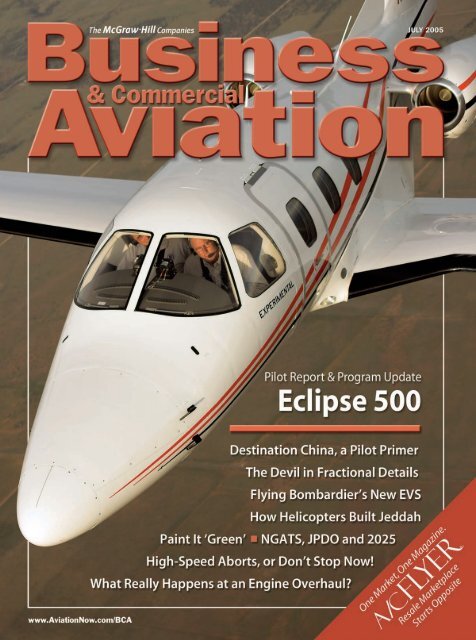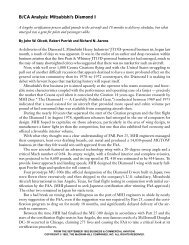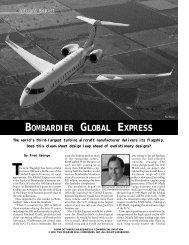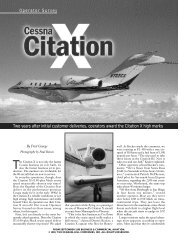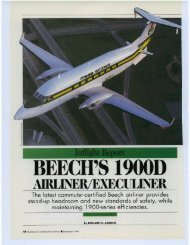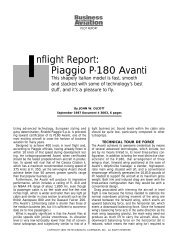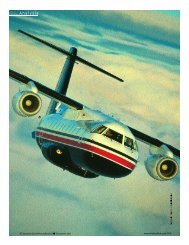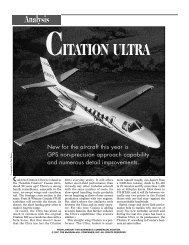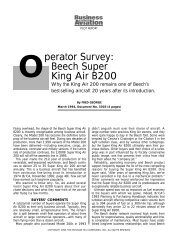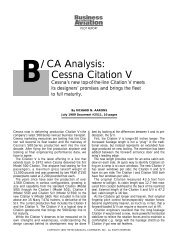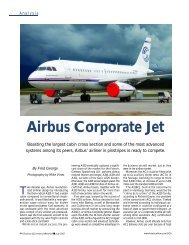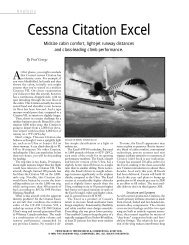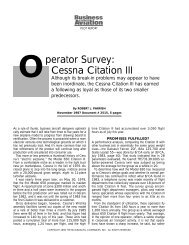Pilot Report B&CA July 2005
Pilot Report B&CA July 2005
Pilot Report B&CA July 2005
Create successful ePaper yourself
Turn your PDF publications into a flip-book with our unique Google optimized e-Paper software.
<strong>Pilot</strong> <strong>Report</strong><br />
2 Business & Commercial Aviation ■ <strong>July</strong> <strong>2005</strong><br />
www.AviationNow.com/B<strong>CA</strong>
Eclipse 500<br />
Program Update<br />
We fly the first VLJ in production configuration during<br />
a break in the race to March 2006 certification.<br />
Text by Fred George<br />
Photography by Phil Forbert<br />
Eight years ago, Vern Raburn, president<br />
and CEO of Albuquerque-based<br />
Eclipse Aviation, made the biggest<br />
gamble in light jet aviation since Bill Lear introduced<br />
the Learjet 23 in 1963. Raburn bet<br />
that folks would buy hundreds, if not thousands,<br />
of twin turbofan aircraft if they could<br />
be sold for less than $1 million. Best known<br />
outside aviation circles as a high-tech industry<br />
entrepreneur, Raburn is a strong believer<br />
in price elasticity, a concept he claims is often<br />
ignored in general aviation. The main lesson<br />
from the personal computer world is clear:<br />
Offer more value and drive down price, and<br />
you’ll wear out a lot of ballpoint pens signing<br />
sales contracts.<br />
Raburn’s vision was shared by Dr. Sam<br />
Williams, chairman of Williams International,<br />
who dreamed of reinvigorating general<br />
aviation by developing a new generation<br />
of affordable turbofan engines. Both men felt<br />
that there was nothing wrong with the general<br />
aviation market that breakthrough airplanes<br />
at lower prices couldn’t cure. Lear had<br />
priced his light jet at $495,000 in 1963 dollars,<br />
a fraction of what contemporary jets cost<br />
at the time. Raburn and Williams both<br />
dreamed of selling a new generation of jet<br />
aircraft for not much more in mid-1990s dollars<br />
— millions less than the least expensive<br />
entry level jet at the time.<br />
As always in aviation, the pacing item<br />
would be propulsion. Williams believed he<br />
could build and sell light turbofan engines for<br />
as little as $50,000 in volume production.<br />
Raburn immediately was hooked on the concept,<br />
so he joined forces with Williams to develop<br />
a radical new very light jet (VLJ)<br />
powered by Williams’ revolutionary turbofan<br />
engines. Raburn would raise most of the capital<br />
for the program. Williams would supply<br />
Vern Raburn, Eclipse president and CEO<br />
most of the engineering and development.<br />
Both would share the revenues from sales.<br />
“In aviation, it’s always the engines that<br />
have changed things. Sam’s company already<br />
had won NASA’s GAP [General Aviation<br />
Propulsion] contract. I liked this engine technology<br />
because it was a game changer. I saw<br />
this as a really, really, really cool opportunity,”<br />
Raburn explained. Dr. Williams’ FJX<br />
GAP engine evolved into the 770-poundthrust<br />
EJ22 fanjet, intended to power what<br />
would become the Eclipse 500. The<br />
Williams V-Jet II proof-of-concept aircraft<br />
was the inspiration for the Eclipse 500. The<br />
price was pegged at $837,500.<br />
The Eclipse 500, powered by Williams<br />
EJ22 engines, first flew on Aug. 26, 2002. It<br />
was its last flight with those fanjets, as well.<br />
Ongoing problems with the EJ22, according<br />
to Raburn, forced Eclipse to drop the<br />
Williams engine by year’s end.<br />
Some folks thought that was the end of the<br />
Eclipse 500 program, but they soon came to<br />
realize that the airplane was powered more<br />
by Raburn’s passion than by Williams’ engines.<br />
Raburn and his determined team evaluated<br />
alternative engine designs, such as the<br />
Agilis TF1000, Honda HF118, Honeywell<br />
LTF101 and Pratt & Whitney Canada<br />
PW600 in late 2002, and the following<br />
February tapped P&WC to provide the<br />
PW610F — a 900-pound-thrust derivative<br />
of the PW615F chosen to power Cessna’s<br />
Citation Mustang. Fuel capacity would be increased<br />
by adding small tiptanks. Eclipse also<br />
raised the price to nearly $1 million for existing<br />
customers. New orders were taken at<br />
$1.2 million. Type certification and initial<br />
customer deliveries were rescheduled for first<br />
quarter 2006.<br />
But the PW610F wouldn’t even be ready<br />
for flight test until late 2004. So, in May 2003,<br />
Eclipse resumed flight tests with a pair of<br />
“interim” Teledyne Continental model 382-<br />
10E cruise missile engines mounted on its<br />
aircraft. This enabled Eclipse to continue<br />
aerodynamic development of the airframe,<br />
even including leading edge ice shapes, pending<br />
the arrival of its new Pratts.<br />
Always pressing the limits of technology,<br />
Raburn planned to fit the PW610Fs with<br />
brushless AC starter/generators that would<br />
have several times the TBO of conventional<br />
DC starter/generators with brushes.<br />
Potentially, this would lower operating costs<br />
and increase dispatch reliability.<br />
Nice try, but no go. The vendor couldn’t<br />
develop the electronics needed to support the<br />
start function of the brushless units on time,<br />
so Eclipse had to fashion its own monstrous<br />
kluge kit, mounted in the cabin, in time to<br />
get the engines started for the first flight in<br />
fourth quarter 2004. Not unexpectedly, there<br />
were several fits and starts as Eclipse’s engineers<br />
struggled with the starter electronics.<br />
Predictably, Eclipse reverted to conventional<br />
DC starter/generators for its subsequent<br />
flight test and production aircraft.<br />
Compounding the start problems, Eclipse<br />
also had numerous problems with the<br />
Hispano-Suiza FADEC and some growing<br />
www.AviationNow.com/B<strong>CA</strong><br />
Business & Commercial Aviation ■ <strong>July</strong> <strong>2005</strong> 3
<strong>Pilot</strong> <strong>Report</strong><br />
Pratt & Whitney Canada PW610F<br />
The Eclipse’s PW610F engines are FADEC-equipped for easy operation and rugged for<br />
low operating cost. At entry-into-service in 2006, they’ll have a 1,750 HSI midlife inspection<br />
interval and a 3,500-hour TBO. Projected overall cost is about $150,000 per<br />
engine, according to Eclipse officials.<br />
Having a thermodynamic rating of 1,112 pounds of thrust, they’re flat-rated to 900<br />
pounds of thrust for takeoff aboard the Eclipse 500 and capable of 990 pounds of thrust<br />
in APR. The engines feature a 14-inch, one-piece, integrally bladed fan and deep-fluted exhaust<br />
mixer nozzle for improved high-altitude performance and lower FAR Part 36 noise<br />
levels. P&WC isn’t using any exotic materials inside and the engine will have modest a<br />
pressure ratio by today’s standards. The result is lower overall operating costs.<br />
P&WC is having plenty of success with the 1,000- to<br />
3,000-pound-thrust PW600 series, all of which<br />
will be FADEC-equipped. Cessna has selected<br />
the PW615F for its<br />
Citation Mustang and<br />
Embraer tapped the<br />
PW617F for its newly<br />
announced VLJ. P&WC<br />
is banking on the<br />
PW600 to be a large<br />
production volume engine,<br />
rivaling the success<br />
of the PT6A turboprop in the<br />
last century.<br />
pains with the PW610F. Hispano-Suiza remains<br />
one of Eclipse’s problem vendors, according<br />
to Raburn, but he cannot say enough<br />
good things about product support from<br />
Pratt & Whitney Canada.<br />
In mid-2004, Raburn invited B&<strong>CA</strong> to<br />
witness the first flight in late November,<br />
rescheduling several times until Dec. 31,<br />
when at 10:16 a.m., the first flight of s.n. 1087,<br />
the first Eclipse 500 in full production configuration<br />
and powered by the PW610F, took<br />
place. We watched the entire first flight from<br />
inside Raburn’s Turbo Commander as he<br />
flew chase on the test aircraft. Both aircraft<br />
taxied into the Eclipse Aviation compound<br />
afterward, where Raburn led a celebration attended<br />
by nearly 1,000 people. “We promised<br />
we’d fly the aircraft with its new engines<br />
before the end of 2004 and we did. Eclipse is<br />
back. Eclipse is here to stay. And Eclipse is<br />
going forward,” Raburn beamed.<br />
Eclipse flight test pilots had completed a<br />
second test flight by late afternoon. At the<br />
end of the day, as the bubbly started flowing,<br />
Raburn promised B&<strong>CA</strong> we’d be flying the<br />
aircraft by May <strong>2005</strong>. He kept his promise,<br />
as we’ve described in the First Flying<br />
Impressions section of this report.<br />
Breakthrough Technologies —<br />
Sharp, Doubled-Edged Swords<br />
Revolutionary new engines and starters are<br />
but two of the potential breakthrough technologies<br />
embodied in the 500. Raburn often<br />
has said that the aviation industry is so risk<br />
averse that technological progress is painfully<br />
slow, manufacturing costs are among the<br />
highest of any industry, quality is marginal<br />
and reliability is low. This is why airplane<br />
prices are so high and they cost so much to<br />
operate, according to Raburn.<br />
When Raburn embarked upon the Eclipse<br />
project, he “saw a technological convergence<br />
that could change everything except aerodynamics.”<br />
It was time to abandon World War<br />
II aircraft manufacturing methods, he said,<br />
along with “Rosie the Riveter in her polka<br />
dot hat whistling ‘Boogie Woogie Bugle<br />
Boy.’” He saw, for example, the potential for<br />
high-speed CNC milling that could make integrated<br />
one-piece parts. Watching automakers<br />
and computer manufacturers<br />
streamline their fabrication processes, he was<br />
inspired to try new methods to produce aircraft<br />
that “could reinvigorate existing markets<br />
and create all-new ones.”<br />
So, Eclipse embraced new technologies<br />
and new general aviation suppliers since its<br />
inception, even if they didn’t have a proven<br />
track record in civil aviation. But Raburn<br />
wasn’t ready to buy off on composites. In<br />
contrast to the V-Jet II, the Eclipse 500’s primary<br />
structure would be all-aluminum because<br />
the aviation industry has upwards of 85<br />
years’ design, fabrication, repair and fatigue<br />
experience with the material. By comparison<br />
Raburn believes that composites are too<br />
much of an unknown commodity in the aviation<br />
community regarding such issues and<br />
that composite construction isn’t well suited<br />
to high-volume production. Still, he has high<br />
hopes for Boeing’s 787 Dreamliner as a composite<br />
pioneer.<br />
Old aluminum construction methods,<br />
however, are expensive since it can take from<br />
4,000 to 5,000 labor hours to build a light jet<br />
airframe. Raburn knew he would have to<br />
slash those hours to keep his price low.<br />
Accordingly, Eclipse employs high-speed<br />
CNC milling and friction stir welding<br />
Similar to CNC milling processes used by<br />
Bombardier, Dassault and Raytheon to fabricate<br />
their latest aircraft, Eclipse is the first<br />
aircraft manufacturer to use such techniques<br />
to build a VLJ. Wing spars, chord-wise<br />
frames and bulkheads, among many other<br />
major airframe components, begin life as<br />
large billets of aluminum fed to CNC mills<br />
that remove 90 to 95 percent of the mass to<br />
transform them into complex shaped parts.<br />
CNC milling makes possible construction of<br />
one-piece components that replace built-up<br />
assemblies of dozens of parts joined by hundreds,<br />
if not thousands, of fasteners.<br />
Unlike Bombardier and Dassault that<br />
have extensive in-house manufacturing centers,<br />
Eclipse won’t do any heavy construction<br />
or machining at its assembly plant at<br />
Albuquerque International Sunport.<br />
Instead, the company farms out processes<br />
like CNC milling to other firms, such as<br />
Fuji Heavy Industries (FHI), Ducommon<br />
AeroStructures, Compass Aerospace and<br />
Empresa Nacional de Aeronáutica in Chile.<br />
These firms have high-speed CNC mills<br />
and manufacturing methods that can support<br />
high volume production of major<br />
subassemblies.<br />
Friction stir welding (FSW), now used extensively<br />
in missile and marine construction,<br />
was invented by The Welding Institute at<br />
University of Cambridge. It uses a spinning<br />
mandrel that bears down on a lap joint hard<br />
enough to create friction heating that welds<br />
the two pieces of material together without<br />
imparting enough heat to liquefy the metal.<br />
The rotating tool bit translates along the lap<br />
joint to create a continuous weld that’s<br />
stronger than a string of mechanical fasteners.<br />
FSW is at least as strong as structural adhesive<br />
bonding, but the resulting joint<br />
weighs much less, is considerably faster to<br />
fabricate and should cost less in high-volume<br />
production.<br />
Prior to the Eclipse 500 development program,<br />
FSW never had been approved as a<br />
process for civil aircraft construction. Seeing<br />
the promise of greatly reduced construction<br />
costs, Eclipse developed FSW for aircraft<br />
fabrication and earned FAA approval for us-<br />
4 Business & Commercial Aviation ■ <strong>July</strong> <strong>2005</strong><br />
www.AviationNow.com/B<strong>CA</strong>
The one-piece main spar carry-through structure (left) and the “banjo” (right), the integrated aft tailcone bulkhead/vertical tail main spar, are milled out of<br />
massive blocks of aluminum by high-speed CNC milling machines. This is emblematic of how Eclipse is wringing out thousands of assembly hours from the<br />
EA 500 production line.<br />
ing FSW in the primary airframe structure,<br />
including fuselage and wings. Eclipse invested<br />
$20 million in FSW, spending about<br />
one-third for tooling and two-thirds for development.<br />
The payoff is the elimination of<br />
almost 7,400 fasteners and 1,000 assembly<br />
hours, according to Oliver Masefield, Ph.D.,<br />
the firm’s senior vice president and senior fellow.<br />
There are almost 442 linear feet of friction<br />
stir welds in the aircraft’s pressure vessel,<br />
wings and aft fuselage sections.<br />
The result is no more than 600 hours to<br />
assemble the aircraft in Albuquerque, outside<br />
of paint work, according to Raburn, plus a<br />
five-fold improvement in tolerance control.<br />
The goal is to produce each aircraft in<br />
Albuquerque in 10 days, including one and<br />
one-half days in production flight test and<br />
two in the painting process.<br />
“We’re fanatical about driving out cycle<br />
time and increasing quality,” Raburn said.<br />
“The single biggest cost in building a conventional<br />
aircraft is overhead, including parts<br />
inventory, manufacturing plant and the cost<br />
of capital. We’ve modeled Eclipse on the best<br />
Japanese lean practices. There, the synonym<br />
for ‘lean’ is ‘continuous improvement.’”<br />
Raburn admits that Eclipse has had to fire<br />
more than a few partners whom he felt<br />
couldn’t perform up to snuff. BAe Systems,<br />
for example, was slated to supply the autopilot.<br />
Now it’s Meggitt. Metalcraft<br />
Technologies was going to build most of the<br />
fuselage. Now, Ducommon and Compass<br />
will supply major subassemblies that will be<br />
completed in-house by Eclipse. Cal-Draulics<br />
was tapped to build the landing gear, but now<br />
it’s Mecaer’s job. Exterior lighting was to be<br />
furnished by Devore Aviation. LSI now will<br />
supply the LED position, beacon and strobe<br />
lights, plus HID landing lights.<br />
“We always assume a partner can live up<br />
to its promises, until it proves otherwise,”<br />
Raburn explained. Old school pundits might<br />
say this approach is overly optimistic and<br />
leads to program delays. Raburn, though, is<br />
determined to achieve new standards for<br />
functionality, dependability and low operating<br />
cost. More changes are likely. Several<br />
suppliers have earned below average marks<br />
for inadequate ramp rate readiness for highvolume<br />
production that is slated to begin in<br />
2007. They must grow production capacity<br />
by at least 50 percent to meet Eclipse’s production<br />
targets. Eight of the 51 suppliers are<br />
being watched closely, because of ramp rate<br />
deficiencies, process control problems or development<br />
shortcomings.<br />
While supplier performance remains a<br />
concern, Raburn’s 425-person team in<br />
Albuquerque is confident they can hold up<br />
their end of the development schedule.<br />
Weight control has become an obsession.<br />
The aircraft was 110 pounds overweight, but<br />
Eclipse had worked off 35 of those pounds<br />
by early June. While suppliers and staff remain<br />
under the gun to reduce weight further,<br />
Raburn said, “We’re pretty comfortable we’ll<br />
be able to make our [projected] performance<br />
and range numbers.”<br />
Interior design, maintenance access and<br />
weight control also are top priorities during<br />
the development process. The entire interior<br />
is designed to be removed and replaced in two<br />
to three hours. All scheduled maintenance<br />
operations, including engine changes, are being<br />
designed to be accomplished in a single<br />
eight-hour shift. Fly all day and fix at night is<br />
how Eclipse is running its flight test program.<br />
The object is to perfect routine maintenance<br />
processes for customers, as much as maximize<br />
aircraft availability for flight test.<br />
Technicalities aside, we wanted to know<br />
how it flew.<br />
First Flying Impressions<br />
Just after returning from EBACE <strong>2005</strong>, we<br />
strapped into the left seat of s.n. 109, the third<br />
flight test aircraft and the one Eclipse will use<br />
primarily for avionics and electric system certification.<br />
Terry Tomeny, director of flight test<br />
engineering, occupied the right seat as pilot<br />
in command.<br />
Aircraft 109 first flew on April 21, <strong>2005</strong>, and<br />
had logged less than 15 hours when we took<br />
the controls on the 18th and 20th missions.<br />
As a result, many functions and systems were<br />
yet to be made fully operational. Flight operations<br />
were limited to daylight VFR, the ceiling<br />
was limited to 25,000 feet and there was a<br />
230 KIAS speed restriction. We also could fly<br />
it no slower than 82 KIAS pending flight envelope<br />
expansion.<br />
The aircraft had most of the production interior<br />
panels installed, because fit, finish and<br />
durability of those parts are being evaluated<br />
during the flight test program, along with the<br />
green airplane. Serial number 109 also had<br />
the usual array of orange test equipment in<br />
the main cabin, bolted down through the carpeting<br />
to the seat rails. Telemetry equipment<br />
aboard the aircraft transmitted hundreds of<br />
channels of data to the Eclipse flight test department,<br />
enabling engineers on the ground<br />
to monitor the aircraft’s engines, systems and<br />
flight controls during our flights. We were<br />
outside line-of-sight telemetry range during<br />
portions of our test flights, so we don’t have<br />
precise data for all phases of the two evaluation<br />
missions.<br />
The aircraft’s empty operating weight was<br />
3,693 pounds, which was at least 300 pounds<br />
heavier than a production aircraft fitted with<br />
www.AviationNow.com/B<strong>CA</strong><br />
Business & Commercial Aviation ■ <strong>July</strong> <strong>2005</strong> 5
<strong>Pilot</strong> <strong>Report</strong><br />
Production aircraft wings will be built by Fuji Heavy Industries. The interior structure has very few parts<br />
outside of the one-piece main- and aft-wing spars and a dozen or so one-piece chord-wise ribs all produced<br />
by high-speed CNC mills.<br />
the LX upgraded interior, thicker insulation<br />
and optional sixth seat. Our two-crew<br />
arrangement raised the zero fuel weight to<br />
4,058 pounds. With a full 1,507-pound fuel<br />
load, the ramp weight was 5,565 pounds, according<br />
to Eclipse’s engineering flight test<br />
department.<br />
Serial number 109’s instrument panel was<br />
very clean, perhaps too clean. Eclipse still is<br />
waiting for Luminescent Systems, Inc., a unit<br />
of Astronics, to deliver the glareshield DFCS<br />
and center console control panels and for<br />
Avidyne to deliver the audio control panels.<br />
At this stage in program development, most<br />
of the technical risk is associated with vendor<br />
delays rather than airframe development,<br />
according to Eclipse officials.<br />
Outside visibility from the cockpit is somewhat<br />
restricted compared to some other light<br />
jets. The windshield is steeply raked and the<br />
top of the instrument panel is relatively high.<br />
Lateral visibility through the side windows is<br />
not as good as in some other light jets. This is<br />
not a problem when looking through the side<br />
window closest to the pilot, but it’s noticeable<br />
when looking through the cross-side window.<br />
However, a pilot can see out through the<br />
cross-side cabin windows, augmenting the<br />
view available through the cockpit windows.<br />
The position of the aircraft’s side stick control<br />
is an almost perfect fit for the pilot’s natural<br />
hand position. It’s angled forward and<br />
inward to match one’s hand position when<br />
the forearm is on an armrest. The grip has a<br />
trigger switch for press-to-talk, plus buttons<br />
for autopilot disconnect, gear warning horn<br />
mute, control wheel steering and all-interrupt<br />
for trim, autothrottle, autopilot and yaw<br />
damper functions. The side stick and short<br />
center console also make it easier to get in<br />
and out of the cockpit, compared with aircraft<br />
that have conventional control wheel<br />
controls and long center consoles. Plan on<br />
flying with a knee board, if there’s someone<br />
occupying the right front seat. Chart and nav<br />
publications storage volume is limited without<br />
the availability of the right front seat<br />
cushion as an ersatz chart table.<br />
Long-legged pilots may find it necessary<br />
to move the rudder pedals aft and position<br />
the crew seat well aft to avoid interference<br />
between the side stick and outboard knee.<br />
Still, the forward section of the fuselage<br />
curves inward toward the nose, so room in<br />
the cockpit isn’t nearly as generous as in the<br />
The one-piece main spars are unusually stout for<br />
a 5,650-pound MTOW aircraft. The Eclipse 500<br />
should sail through static and fatigue tests at<br />
South West Research Institute in San Antonio.<br />
main cabin. Cabin interior shape, though<br />
smaller, feels a little like a Piaggio<br />
P180 Avanti — relatively tight up front and<br />
roomy in the midsection.<br />
The throttle position in the short center<br />
console requires an unsupported reach.<br />
Production aircraft will have crew seat armrests,<br />
in addition to passenger chair armrests,<br />
providing a place to rest one’s forearm behind<br />
the throttles.<br />
The Eclipse 500 promises to be the easiest<br />
to fly twin-engine aircraft yet built, piston or<br />
turbine, because of its docile flying characteristics<br />
and systems automation. This starts with<br />
its AVIO Total Aircraft Integration system, a<br />
design that goes far beyond conventional<br />
avionics integration. AVIO connects with virtually<br />
every system on the aircraft, including<br />
the engines, avionics, dual zone climate control,<br />
pressurization and electrical components.<br />
When fully developed, it will have interactive<br />
normal checklists and abnormal/emergency<br />
checklists that are automatically called up in<br />
response to system malfunctions.<br />
AVIO can be compared to Dassault’s EASy<br />
cockpit, although perhaps it’s even more integrated<br />
with aircraft systems. Both AVIO<br />
and EASy take some time to master because<br />
they’re essentially required crewmembers, albeit<br />
digital entities, on the flight deck. Both<br />
systems feature interactive system synoptics<br />
that are used to control functions, as well as<br />
monitor them. Once a pilot masters AVIO,<br />
the rest of the aircraft will be as easy as a light<br />
piston twin, but without the hassles of catering<br />
to and caring for finicky recip engines,<br />
and with virtually no asymmetric thrust.<br />
Notably, the aircraft will have better one-engine-inoperative<br />
takeoff performance than<br />
most FAR Part 23 twin turboprops, but<br />
VM<strong>CA</strong> will be considerably lower than stall<br />
speed in any configuration.<br />
Switch and knob position conventions are<br />
logical. When the switch blades are in the<br />
down position, the function is off, open or<br />
disabled. Up is for activation or normal inflight<br />
mode. Knobs are positioned left for off,<br />
12 o’clock for normal and right for special or<br />
abnormal functions. The LED nav lights<br />
come on as soon as electrical power from any<br />
source is switched on. The red LED beacons<br />
and white LED strobes are controlled by a<br />
single three-position switch with off, beacon<br />
and beacon/strobe stops.<br />
Starting the aircraft consists of flicking up<br />
five electrical panel switches, checking battery<br />
or external power voltage and then<br />
pressing down and turning each engine control<br />
knob from the nine o’clock to 12 o’clock<br />
position. The on-side fuel boost pump automatically<br />
operates, the starter spins up the<br />
engine and the FADEC handles all the other<br />
chores. After start, the generator automatically<br />
comes on line in production aircraft and<br />
6 Business & Commercial Aviation ■ <strong>July</strong> <strong>2005</strong><br />
www.AviationNow.com/B<strong>CA</strong>
the boost pump shuts off. Each engine’s<br />
FADEC automatically terminates the start in<br />
case of a malfunction.<br />
Interior sound levels, even with the test<br />
aircraft’s acoustical insulation package, were<br />
low. The engine inlets are well behind the aft<br />
pressure bulkhead and partially masked by<br />
the fuselage midsection contours. Total fuel<br />
flow at idle was 197 pph.<br />
Each of the PW610F turbofans, in current<br />
configuration, produces about 40 pounds of<br />
idle thrust. Once the aircraft is rolling, frequent<br />
use of wheel brakes is needed to check<br />
taxi speed. An upcoming FADEC software<br />
revision should reduce ground idle<br />
thrust to 25 pounds of thrust. That should<br />
alleviate most of the need to use the brakes<br />
during taxi and also reduce ground idle fuel<br />
flow.<br />
Nosewheel steering authority during taxi<br />
through the rudder pedals is mushy at best,<br />
in B&<strong>CA</strong>’s opinion. We’d like to see pedal<br />
steering made crisper. Tight turns require<br />
liberal use of differential braking. The aftmounted<br />
engines are spaced so closely together<br />
that using differential thrust to tighten<br />
the turn is virtually ineffective.<br />
Takeoff V speeds for our flights were<br />
padded by five to 10 knots, pending full expansion<br />
of the flight envelope. Rotation, for<br />
instance, was pegged at 94 KIAS and liftoff<br />
was set for 100 KIAS. We set the fowler flaps<br />
to 10 degrees for takeoff, a position that<br />
causes them to move aft on their tracks by<br />
several inches, thereby increasing wing chord<br />
for substantially more lift.<br />
The OAT was 34°C, local altimeter was<br />
30.10 and Albuquerque’s field elevation is<br />
5,355 feet, so density altitude was close to<br />
8,375 feet. The hot-and-high field conditions<br />
sapped engine performance, but the PW610F<br />
has an APR feature that boosts thrust by<br />
10 percent if needed in the event of a oneengine-inoperative<br />
takeoff.<br />
Once cleared for takeoff on Runway 08, we<br />
pushed up the throttle levers to the stops.<br />
Fuel flow stabilized at 955 pph. Acceleration<br />
was modest, as expected, in light of the hotand-high<br />
conditions. We rotated at 94 KIAS,<br />
noting a little more aft stick force required<br />
than one might expect in an airplane weighing<br />
less than three tons. That’s undoubtedly<br />
the result of the main landing gear being positioned<br />
well aft of the center of gravity. Once<br />
we lifted off at 100 KIAS, considerably less<br />
stick force was needed to control pitch. Roll<br />
control authority was good, but a little heavy<br />
in force. Eclipse engineers plan modifications<br />
that will reduce roll control effort. Passing<br />
through 400 feet agl, we retracted the flaps<br />
at 110 KIAS and reduced thrust for climb,<br />
noting 830 pph total fuel flow.<br />
As speed increased, we observed that there<br />
was only modest pitch force change with air-<br />
AVIO – The Next Step in Total Aircraft Integration<br />
Few aircraft in the world have more avionics and systems integration than the Eclipse.<br />
Most aircraft that boast this level of integration actually have federated systems,<br />
collections of independent systems and avionics boxes that function like a union of<br />
independent member states.<br />
Not so with AVIO. This truly is a full integration of avionics using hub-and-spoke architecture<br />
between the core computers and virtually everything electrically powered<br />
on the aircraft. AVIO’s dual computers replace dozens of stand-alone computers installed<br />
on other light jets. The core hub hosts FADECs, FMS, secondary flight controls,<br />
autothrottle, digital flight control system and control of landing gear, pressurization<br />
and air-conditioning.<br />
AVIO will set new standards for light jet avionics performance. It will have a fully functional<br />
FMS that supports all ARINC 424 procedures and airways navigation, full authority<br />
autothrottles, weight-and-balance and airport performance computers with<br />
automatic V speed bugging on the PFD. Comm and nav radio frequencies will be<br />
stored in the FMS and popped into the standby windows of those radios at the touch<br />
of a button. The FMS will host a simplified advisory VNAV function and it will support<br />
all types of WAAS approaches, including precision approach procedures.<br />
The large central MFD will feature full EI<strong>CA</strong>S, interactive normal, abnormal and<br />
emergency checklists, graphic system synoptics and system control functions. The<br />
final version will have single-level access to all menus, controlled by individual line select<br />
keys or knob controls.<br />
Dual aviation grade byte-flight data busses, as well as some conventional ARINCspec<br />
links, are used as the communications spokes between components and AVIO’s<br />
twin central computers. The system has extensive maintenance history and exceedance<br />
event logging capabilities. As an added benefit, AVIO’s total integration<br />
will result in lower manufacturing costs.<br />
With the exceptions of the manually operated primary flight controls and hydraulic<br />
wheel brakes, every other system on the aircraft is electrically actuated. Left- and<br />
right-side engine-driven generators, plus forward and aft batteries, power all the electrical<br />
systems. Virtually all motors are long-wear DC brushless designs, except for the<br />
starter/generators. Stepper motors, slaved to the FADECs, schedule fuel flow to the<br />
engines.<br />
What if both generators fail? Statistically, that’s mighty improbable based upon<br />
over 40 years of business jet operating history. But if that were to occur, there’s still<br />
at least 30 minutes of battery power. After half an hour, the pilot can shut down one<br />
engine, if needed for descent and landing, to control thrust and then use gear and<br />
flaps to modulate speed. On short final, the other engine can be shut down and the<br />
aircraft can be stopped on the runway using wheel brakes.<br />
www.AviationNow.com/B<strong>CA</strong><br />
Business & Commercial Aviation ■ <strong>July</strong> <strong>2005</strong> 7
<strong>Pilot</strong> <strong>Report</strong><br />
speed change, a possible result of airfoil design<br />
and the T-tail configuration. It was easy<br />
to keep up with pitch trim changes as airspeed<br />
increased, using the four-position elevator/aileron<br />
trim switch atop the side stick.<br />
It has a comfortable rate of travel that accommodates<br />
rapid trim changes up with<br />
pitch force changes at low speed and avoids<br />
over trimming at high speed.<br />
The aircraft has excellent short period<br />
pitch and roll stability, plus strong spiral stability.<br />
Although yaw stability isn’t its strong<br />
suit, prompt rudder pedal inputs quickly<br />
dampen oscillations. In addition, the rudder<br />
on the test aircraft has yet to be modified<br />
with production-configuration trailing edge<br />
wedges that should promote clean flow separation<br />
and help dampen yaw perturbations.<br />
Without rudder inputs, the aircraft has a<br />
natural 2.5-second yaw period and prominent<br />
yaw-roll coupling (Dutch roll), especially<br />
with its short coupling about all three axes.<br />
The aircraft has very little rotational or translational<br />
inertia. Production aircraft will be fitted<br />
with yaw dampers.<br />
The stability checks also revealed noticeable<br />
latency in the PFD and standby attitude<br />
indicator. Yaw, pitch and roll indications<br />
lagged actual aircraft attitude changes by several<br />
degrees. This display latency also is noticeable<br />
when making system configuration<br />
changes through AVIO. An upcoming software<br />
update from Avidyne, supplier of the displays<br />
and radios, should solve latency<br />
problems. The Eclipse 500 has very little inertia<br />
because it’s so lightweight. Slam the<br />
throttle forward and you’ll notice immediate<br />
acceleration, initially accompanied by a slight<br />
nose-down pitching moment. Pull the thrust<br />
levers to idle and the aircraft slows down right<br />
away, however, at first, with a slight nose-up<br />
pitching moment caused by thrust reduction.<br />
At 15,000 feet, we checked low altitude<br />
max cruise speed performance. At a weight<br />
of 5,270 pounds, the aircraft achieved an indicated<br />
airspeed of 223 KIAS and a cruise<br />
speed of 288 KTAS while burning 760 pph in<br />
ISA+26°C conditions. At 200 KIAS, fuel flow<br />
dropped to 650 pph and the aircraft cruised<br />
at 260 KTAS. Fuel flow was 560 pph at 180<br />
KIAS, 425 pph at 150 and 380 pph at 120<br />
KIAS. Down at 15,000 feet, the Eclipse 500<br />
achieved specific ranges of 0.37 nm/lb to 0.41<br />
nm/lb, depending upon cruise speed. It’s essential<br />
to put these numbers into context.<br />
Serial number 109 has substantially more airframe<br />
drag than a production aircraft because<br />
of the relatively abrupt transition between<br />
the wing deice boots and the wing top surface,<br />
plus it has numerous exposed washers<br />
that secure various composite pieces onto the<br />
aluminum airframe.<br />
Cruise performance was better at FL 250,<br />
as expected. That’s as high as we could fly<br />
Generous ground effect and long-travel, trailinglink<br />
main landing gear all but eliminate any<br />
possibility of making a bad landing. The landing<br />
gear are electrically actuated. The only hydraulic<br />
system on the aircraft is the wheel brakes.<br />
pending the outcome of high-speed flutter<br />
tests that were slated for June. At a weight of<br />
5,100 pounds, we accelerated to 170 KIAS.<br />
The aircraft cruised at 255 KTAS while burning<br />
480 pph. Slowing to 154 KIAS, fuel flow<br />
dropped to 400 pph and the aircraft cruised at<br />
231 KTAS — a speed not unlike that of an<br />
entry-level twin turboprop. We concluded<br />
that while the Eclipse 500 indeed is efficient,<br />
it’s still a jet. Maximum speed and range performance<br />
will require flying in the mid- to<br />
high thirties.<br />
Slow speed handling is one of the aircraft’s<br />
strong suits. Extending the gear produces a<br />
noticeable, but easily controllable, nose-up<br />
pitching moment while the gear is in transition.<br />
Extending the flaps to the first notch,<br />
the takeoff position, also produces a mild<br />
nose-up pitching moment. Further extension<br />
to the approach position causes a slight nosedown<br />
pitching moment. The transition to<br />
full flaps causes very little trim change. The<br />
electric trim has plenty of rate authority to<br />
keep up with such configuration-induced<br />
trim changes and there’s ample thrust to<br />
check deceleration, even at 15,000 feet.<br />
The landing pattern is where the Eclipse<br />
500 excels relative to other turbine aircraft,<br />
as well as most piston twins still in production.<br />
We entered downwind, slowing to 110<br />
KIAS in the clean configuration. The aircraft<br />
was quite comfortable at that speed with ample<br />
stall margin, but the nose was cocked up<br />
at five-plus degrees. We extended the flaps to<br />
the 10-degree takeoff position, enabling us to<br />
lower the nose to an almost flat attitude.<br />
There was some aerodynamic noise from the<br />
flaps, and a slight increase in thrust was<br />
needed to stabilize at 110 KIAS.<br />
We flew the pattern fairly tightly, extending<br />
the gear when abeam the downwind<br />
numbers along with approach flaps. We<br />
turned to base almost immediately and<br />
slowed to 100 KIAS. Turning final, we extended<br />
the flaps to the landing position and<br />
slowed to 85 KIAS, the slowest we could fly<br />
until stall testing is complete. Even so, that<br />
speed was the slowest we’ve yet flown an approach<br />
to landing in a civil jet. It was considerably<br />
slower than we could fly in virtually<br />
any twin turboprop business aircraft. We’d<br />
not feel comfortable flying that slowly on final<br />
in most piston twins.<br />
About 30 feet above the runway we pulled<br />
the throttles to idle. The aircraft decelerated<br />
quickly in the flare. There was plenty of<br />
ground effect to cushion the landing and the<br />
generous travel, trailing link landing gear<br />
made for a soft touchdown. After several<br />
touch-and-goes, we concluded that it’s virtually<br />
impossible to make a bad landing in<br />
the Eclipse 500.<br />
On one touch-and-go, we retarded the<br />
right throttle to idle at rotation to simulate a<br />
one-engine-inoperative takeoff. Mild rudder<br />
pressure checked the yaw rate and the aircraft<br />
climbed straight ahead with very little aileron<br />
input. After gear retraction, we recorded a<br />
500 fpm climb in spite of Albuquerque’s hotand-high<br />
density altitude conditions.<br />
Our final approach was Tomeny’s trademark<br />
Simulated Flameout approach, starting<br />
out at high key above the runway downwind<br />
numbers, not unlike a single-engine fighter<br />
that’s run out of fuel. But in the Eclipse 500,<br />
we only had to be 2,000 feet agl above the<br />
runway at high key at 120 KIAS, descending<br />
at idle to and 1,000 feet agl at low key abeam<br />
the numbers. We extended the gear and flaps<br />
to approach and flew a right racetrack pattern<br />
to final, slowing to 100 KIAS with 90 degrees<br />
turn to go and 500 feet agl remaining<br />
altitude. On final, we slowed to 90 KIAS and<br />
coasted in for a smooth touchdown. Runway<br />
deceleration was sluggish, though. There is<br />
excessive ground idle thrust pending a<br />
FADEC software revision; furthermore, we<br />
landed with a slight tailwind and the wheel<br />
brakes were a little spongy.<br />
All of this seemed fairly routine until we<br />
returned home and jumped into an F33A<br />
Bonanza the following weekend. It was then<br />
we put the two Eclipse 500 flights into perspective.<br />
This is an aircraft that promises<br />
better-than-Citation II cruise speed, twinpiston<br />
fuel efficiency in cruise and almost<br />
Bonanza-like docility in the landing pattern.<br />
In less than three hours in the Eclipse 500,<br />
8 Business & Commercial Aviation ■ <strong>July</strong> <strong>2005</strong><br />
www.AviationNow.com/B<strong>CA</strong>
we felt far more comfortable than after<br />
dozens of hours in any single- or multiengine<br />
turboprop. In our opinion, any pilot<br />
who has mastered a high-performance piston<br />
twin will find the Eclipse 500 far easier<br />
to fly, especially in the event of an engine<br />
failure on takeoff.<br />
Nine Months Until TC, If . . .<br />
Raburn and his team believe that they can<br />
earn FAA type certification by March 31,<br />
2006. They allow that the program is 45 days<br />
behind schedule in late May and that the<br />
“largest area of concern is now the flight test<br />
program.” Last winter’s El Niño put an IFR<br />
damper on test flying for several days.<br />
N503EA, the first fully conforming test aircraft,<br />
flew only 18 hours in the first 90 days,<br />
but it then flew three times that amount in<br />
the following 60 days.<br />
But flight test progress is accelerating.<br />
N503EA was a work in progress on its first<br />
two flights on Dec. 31, 2004. One wing had<br />
a slight warp, the nosewheel was prone to<br />
shimmy, the cabin wouldn’t pressurize and<br />
the engines were difficult to start because of<br />
the experimental brushless AC starter/generators.<br />
That’s all been cleaned up now. A<br />
new wing has been fitted to the airplane, production<br />
starters have been installed, a new<br />
nosegear has been fitted and all systems are<br />
go. The aircraft will be dedicated to FAA certification<br />
testing for mechanical systems.<br />
N502EA (s.n. 103), the second flight test<br />
aircraft, first flew on April 14, <strong>2005</strong> and<br />
shortly it will start high-altitude flutter tests,<br />
with full FAA certification testing for aerodynamics<br />
and structures to follow. N504EA<br />
(s.n. 109), first flown on April 21 and that<br />
which we flew for this report, will be used for<br />
AVIO, avionics and systems development,<br />
among other tasks. N505EA, the first of two<br />
beta-test aircraft, was to enter flight test by<br />
mid-June, pending engine deliveries. The<br />
fuselage of N506EA, the second beta-test aircraft,<br />
is nearly complete and it’s almost ready<br />
for wing mate. The static test article has been<br />
shipped to Southwest Research Institute in<br />
San Antonio, and the fatigue test article airframe<br />
soon will have its tailcone mounted to<br />
the airframe. Soon thereafter, wing mate<br />
will occur.<br />
The flight test team has a new U.S. Air<br />
Force fighter pilot can-do approach due to<br />
the influence of Tomeny, who is expected to<br />
attract like-minded test pilots to the Eclipse<br />
500 development program. The pace of<br />
flight test operations is accelerating and the<br />
trend is fast absorbing the 45-day lag in program<br />
development. Type inspection authorization<br />
now is slated for August, a lean seven<br />
months prior to Eclipse’s March 31, 2006,<br />
goal for type certification.<br />
Every aspect of the program under the di-<br />
LED position and strobe lights at the wingtips<br />
have 10,000-plus-hour service lives. This is part<br />
of Eclipse’s drive to improve dispatch reliability<br />
by several orders of magnitude over current production<br />
light jets.<br />
rect control of Eclipse employees appears to<br />
be proceeding apace. Reminiscent of the<br />
Larry Bossidy era at AlliedSignal, most folks<br />
at Eclipse now view weekends as workdays<br />
with less road traffic and fewer phone calls.<br />
Having already raised nearly $400 million in<br />
equity, Raburn has launched a final round of<br />
private equity fund-raising, with the goal of<br />
preparing for full-scale production, training<br />
and support, as well as aircraft type certification.<br />
“We’re going to keep fortifying this<br />
company” to assure its success and growth,<br />
Raburn asserts.<br />
But Raburn and others seem a little edgy<br />
N505EA and N506EA, the two beta-test Eclipse<br />
500 aircraft, are nearing final assembly. These<br />
aircraft also will be used, if needed, to supplement<br />
the flight test aircraft to finish the program<br />
on schedule so that type certification can be<br />
earned by March 31, 2006.<br />
when probed about the fitness of certain outside<br />
vendors. Chief Financial Officer Peter<br />
Reed, senior vice president of finance and administration,<br />
is wearing out the carpet between<br />
his office and Raburn’s as the two meet<br />
several times per day to discuss supplier<br />
problems, such as technical development<br />
progress, production process controls, overdue<br />
certification documents and ramp up capacity<br />
deficiencies.<br />
Eclipse officials are stepping up their onsite<br />
visits to vendor facilities. Several vendors<br />
will be able to meet Eclipse’s goal of building<br />
150 aircraft in 2006, but some will struggle<br />
to ramp up to a production rate of 600<br />
aircraft per year in 2007. Eclipse now has 40<br />
people working full time on supplier ramp<br />
up issues in 2007 and 2008.<br />
Raburn remains confident Eclipse can<br />
make its March 31, 2006, type certification<br />
goal, “but there are a number of events on the<br />
part of the vendors that drive the game.”<br />
While he avows the deadline is achievable, he<br />
also admits “we’re out of pad.” He’s hopeful,<br />
but he admits “there are days when it gets<br />
very frustrating, when I get very tired. If I had<br />
known how hard it would be, I probably<br />
wouldn’t have done it.”<br />
In the midst of all of this, Raburn has been<br />
highly complimentary of the support Eclipse<br />
has received from the FAA. “The regulatory<br />
process has not been a surprise and I believe<br />
that it’s the most maligned process in aviation.”<br />
The FAA has furnished many more solutions<br />
than problems, according to Raburn.<br />
It’s basically a matter of explaining your case<br />
to the right FAA people, he maintained.<br />
Paraphrasing Charles Dickens, Raburn says<br />
it’s been the best of times and the worst of<br />
times. One of his biggest challenges has been<br />
an aviation supply chain that’s geared up for<br />
1950s technology, production methods and<br />
quality control. His biggest surprise has been<br />
the quality of people Eclipse has attracted to<br />
the program, folks from Boeing, the U.S.<br />
Navy and U.S. Air Force flight test center and<br />
general aviation veterans, plus fresh all-star<br />
aviation graduates from the University of<br />
North Dakota and Embry-Riddle.<br />
While the odds that Eclipse will win its race<br />
to March 31, 2006, type certification may not<br />
be in Raburn’s favor, it would be imprudent<br />
to underestimate him, based upon his ability<br />
to overcome formidable challenges from the<br />
start of the program.<br />
Besides, that date may be irrelevant to the<br />
first customers. From what we’ve seen on the<br />
ground and in flight, a few extra days, some<br />
weeks or even a couple of months will be well<br />
worth the wait. When initial Eclipse 500 deliveries<br />
begin in 2006, the face of general aviation<br />
could change as much as it did over<br />
40 years ago when first deliveries of the<br />
Learjet 23 began. B&<strong>CA</strong><br />
Posted from Aviation Week, <strong>July</strong> <strong>2005</strong>, copyright by The McGraw-Hill Companies, Inc. with all rights reserved.<br />
This reprint implies no endorsement, either tacit or expressed, of any company, product, service or investment opportunity.<br />
#1-10788404 Managed by Reprint Management Services, 717.399.1900. To request a quote online, visit www.reprintbuyer.com.


